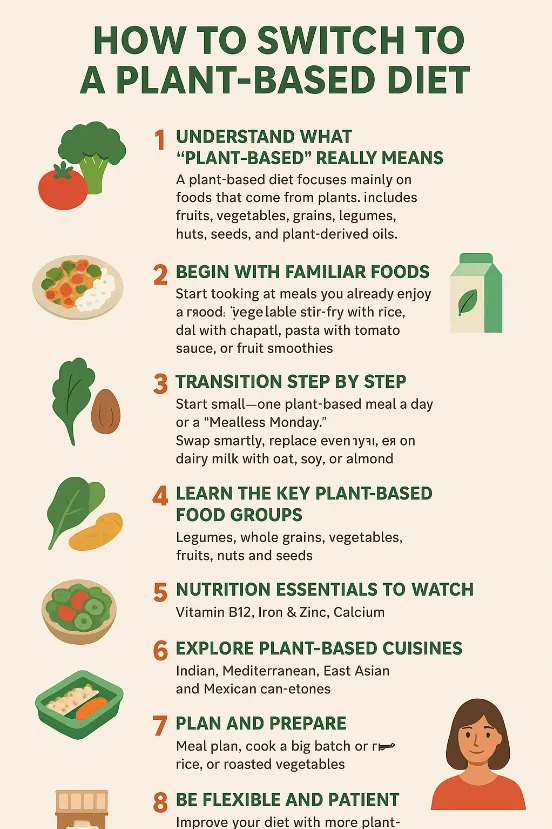Adopting a plant-based diet is becoming increasingly popular around the world. People are choosing this lifestyle for better health, environmental sustainability, and compassion for animals. But for many, the question is not why but how to actually make the switch. Transitioning doesn’t have to be difficult — with the right knowledge and approach, it can be enjoyable, satisfying, and sustainable in the long run.
1. Understand What “Plant-Based” Really Means
A plant-based diet focuses mainly on foods that come from plants. This includes fruits, vegetables, grains, legumes, nuts, seeds, and plant-derived oils. Some people follow it strictly (vegan), while others may allow occasional animal products (plant-forward or flexitarian). What matters most is that plants make up the foundation of your meals.
2. Begin with Familiar Plant-Based Diet
The easiest way to start is by looking at meals you already enjoy. For example, vegetable stir-fry with rice, dal with chapati, pasta with tomato sauce, or fruit smoothies are already plant-based. Instead of changing everything at once, simply expand these options and add new plant-powered dishes gradually.
3. Transition Step by Step
- Start small: Try one plant-based meal a day or a “Meatless Monday.”
- Swap smartly: Replace dairy milk with oat, soy, or almond milk. Use beans, lentils, or tofu instead of meat in curries and stews.
- Increase gradually: Over weeks, shift more meals to plant-based until it becomes your normal eating pattern.
This gradual change is easier to sustain than making a sudden, drastic shift.
4. Learn the Key Plant-Based Food Groups
To feel full and energized, variety is essential. Your diet should include:
- Legumes: beans, chickpeas, lentils, peas, tofu, tempeh.
- Whole grains: brown rice, quinoa, oats, millet, whole wheat.
- Vegetables: leafy greens, cruciferous veggies, colorful seasonal produce.
- Fruits: fresh, dried, and frozen options.
- Nuts and seeds: almonds, walnuts, chia, flax, sesame, sunflower.
- Healthy fats: avocado, olives, nut butters, seeds.
5. Nutrition Essentials to Watch
While Plant-Based Diet provide most nutrients, there are a few areas that need special attention:
- Vitamin B12: not naturally found in plants; take a supplement or consume fortified foods.
- Iron & zinc: found in lentils, beans, pumpkin seeds, but best absorbed with vitamin C foods like lemon, oranges, or tomatoes.
- Calcium: available in fortified plant milk, tofu, almonds, sesame seeds, and leafy greens.
- Omega-3 fatty acids: get them from chia seeds, flaxseeds, walnuts, or algae-based supplements.
6. Explore Plant-Based Cuisines
Many global Plant-Based Diet traditions are naturally plant-rich:
- Indian cuisine: dals, vegetable curries, chana masala, idli with sambar.
- Mediterranean cuisine: hummus, falafel, tabbouleh, olive oil-based salads.
- East Asian cuisine: tofu stir-fries, miso soup, vegetable sushi.
- Mexican cuisine: bean tacos, vegetable enchiladas, rice bowls.
Experimenting with these flavors keeps meals exciting and prevents boredom.
7. Plan and Prepare
Meal planning saves time and ensures balance. Cook a big batch of beans, rice, or roasted vegetables to use in different recipes throughout the week. Keep quick snacks like fruits, nuts, or hummus with veggies available, so you never feel stuck.
8. Be Flexible and Patient
You don’t need to be perfect overnight. Some people go fully vegan, while others remain mostly plant-based with occasional animal products. The key is progress, not perfection. Every step toward more plant-based meals benefits your health and the planet.
- India-New Zealand FTA का ‘ग्रैंड विजन’:प्रशांत महासागर से हिंद महासागर तक 2025
- चूड़ियों की खनक और हवा का भारीपन: क्या Firozabad AQI 144 वाकई ‘सामान्य’ है?
- कांच की चमक और धुंधलाता आसमान: Firozabad AQI 188 का असली सच
- When Google Pulls the Plug: How the December 2025 Core Update Threatens the Economics of Online News
- Firozabad AQI Today: Latest Pollution Levels and Health Advisory for Residents
Benefits You Can Expect
- Health: lower risk of heart disease, diabetes, obesity, and certain cancers.
- Energy: plant foods are rich in fiber, vitamins, and antioxidants.
- Environment: reducing animal products lowers carbon footprint and saves resources.
- Ethics: fewer animals harmed in food production.
Final Thoughts
Switching to a plant-based diet is not about restriction — it’s about abundance. By filling your plate with colorful, nourishing Plant-Based Diet, you open yourself to new flavors, better health, and a more sustainable lifestyle. Start small, stay consistent, and enjoy the journey.
- iPhone 17 Pro Max Launch Date: 10 Reasons to Wait for iPhone 17 Series
- Green Vegetables Benefits – हरी सब्ज़ी खाने से होने वाले 10 बड़े फायदे
- क्या BRICS देश मिलकर अपनी मुद्रा बना सकते है?
- QUAD की बैठक; India-America की तनातनी के बीच क्या रद्द होगी ?
- JPG to PNG to WEBP converter
- Convert Any File Into PDF
- Facts About Tomatoes That You May Not Know
- Age Calculator
- Rashii Khanna: Biography, Career, Movies, Awards and Unknown Facts
- Vicky Kaushal & Katrina Kaif Announce Pregnancy: A New Chapter Begins

1 thought on “How to Switch to a Plant-Based Diet: A Complete Guide”